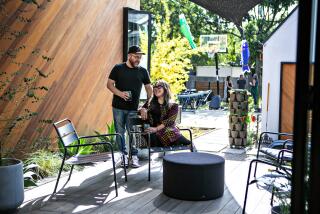China exports a family house and its history
- Share via
SALEM, Mass. — Its name means “Hall of Plentiful Shelter,” and for almost two centuries, the Yin Yu Tang house provided just that to the Huang family in the remote Huizhou region of China.
But by the mid-1980s, the clan had scattered and the home was abandoned. In 1996, the family gathered there to decide the house’s fate.
It was then that a remarkable coincidence saved it from destruction and set its future across the ocean.
Nancy Berliner, the curator of Chinese art at the Peabody Essex Museum, was in the region when she passed the house’s open door, walked in according to common Chinese practice and found herself in the family meeting. A discussion ensued and Berliner eventually made a proposal: Why not move the house to America?
Six years later, the house is being reconstructed, piece by piece, on the museum grounds of this coastal city.
More than 2,700 wooden pieces were among the original stones, bricks and tiles shipped from China to New York City in 18 cargo containers in early 1998. A team of Chinese and American artisans has been reassembling it.
The $15-million project is the first to transplant an entire Chinese house to the United States and has the potential to influence Western architecture by giving greater exposure to Chinese practices, says Ronald Knapp, an expert in Chinese folk architecture from the State University of New York at New Paltz. “The scope of it is really extraordinary,” he says.
Yin Yu Tang belonged to merchants, not royalty, and Berliner says it will provide a look into everyday middle-class Chinese life that most Westerners have never seen. “People lived here,” she says. “It’s not a temple; it’s not a shrine. It has a life and it has many lives that were inhabiting it.”
The house is scheduled to open in June as part of a $125-million expansion at the museum, which was founded in the 18th century by Far East traders and has a collection that spans numerous mediums and cultures.
Museum officials view the house as a Chinese counterpart to the Federal-style houses those traders built in Salem.
Yin Yu Tang’s exterior is stone and brick covered with lime plaster over a wooden post and beam frame. Inside, the reconstructed home will display intricate latticework and stone column bases.
Its central feature is an open-air courtyard, called a “sky well,” with two fish ponds.
Yin Yu Tang will be restored to its condition in the 1980s, when the family last lived there full time, and contain the furniture and artifacts collected over a 200-year history that was sometimes tumultuous for both a nation and a family.
The two-story, 2,600-square-foot building housed generations of the Huang family at once, and room assignments reflected the family hierarchy. The oldest and most respected members occupied rooms closest to the east and the rising sun.
The Chinese emphasis on family is further shown in window placement, Berliner said. The exterior windows are few and small, measuring about a foot square. By contrast, interior windows are broad and face the courtyard that was the center of family life.
The house was constructed with wooden pegs and joints, fitting together like a giant jigsaw puzzle. The delicate and detailed work has been completed in a warehouse in the nearby town of Melrose, where sections are reconstructed, and at the Salem site where the house will stand.
Chinese artisans, often using Chinese tools, are guiding the process. Some concessions must be made to fit local building codes, such as eliminating three of the four kitchens to fit an elevator for handicapped access.
The entire project is a look inside the rich field of Chinese folk architecture, which Knapp said is relatively untapped because of so much turmoil in China over the years.
In the Chinese tradition, homes are designed to work with nature. For example, they are positioned to take advantage of prevailing winds.
Those features will be obvious to any visitor to Yin Yu Tang and could open new avenues into Western practices, Knapp says.
“I think architectural students and the public alike will see it very clearly,” he said. “I think it will offer inspiration.”
As part of the agreement that brought Yin Yu Tang to the U.S., the Peabody Essex Museum has agreed to help restore a 16th century shrine and three 17th century homes in the Huizhou region.
More to Read
Sign up for Essential California
The most important California stories and recommendations in your inbox every morning.
You may occasionally receive promotional content from the Los Angeles Times.












